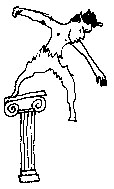 “Teach
us to care and not to care.
“Teach
us to care and not to care. Mark Bloch says: I was first made aware of St. Simeon Stylites when I saw Luis Buñel’s SIMON OF THE DESERT in 1975 or so. It knocked me out. Twenty years later as I waited for my son to be born, I read the text that follows in a book I found, SAINTS FOR NOW edited by Clare Boothe Luce (Sheed and Ward, Inc. 1952). Again, I was knocked out by the concept of an ascetic who sits on a pillar to show his devotion to God. I looked for a long time for more about the writer George Lamb. According to a web page I finally found, he is a historian, translator and apparently a big fan of organized religion. See the text that is indented below and more at the bottom of this page. You'll read more about Lamb and about the book this came from. But mostly you’ll learn more about this wacky saint! Enjoy! And make sure you see Buñel’s film.
From a 1998 BBC web page: Author George Lamb was a latter-day fan of Simeon Stylites. He wrote in 1952 : “ Simeon seemed to have become famous…by doing absolutely nothing. He had done nothing, and got paid for it, so to speak. This struck me as pretty shrewd. I was lazy by nature in those days.”
St Simeon Stylites (pron: sty-lite-ees), who lived near Antioch from 387 to 459, roadtested a variety of activities to find something that would take him closer to God. These included tying rope around himself until his flesh rotted and teemed with worms, burying himself up to his neck for a few months, and living in a small dome chained to an iron ball for 10 years.
Climbing a pillar 60 feet high (18 metres), he stayed there until he died, 36 years later. He spent his years preaching and gaining admirers, and even had a number of followers who also took to the top of pillars. They became known as Stylites.
But Lamb did point to one of the reasons the Roman Catholic Church has venerated St Simeon: “ There is safety in numbers, and so Simeon went up there alone; there is dizziness for the timid at the prospect of great heights, and Simeon faced it.”
St. Simeon was a Peculiar Person; of that there can be doubt. To live on top
of a pillar for thirty-odd years marks a man out in history whether he has the
incidental value of being a saint or not. And so St. Simeon was a favourite
of mine long before I was a Catholic, long even before I knew he was a saint.
Somebody produced a one-act play at school, I remember, in which this weird
creature appeared as hero; whether the play was funny or not I can’t remember,
though being a schaol play it probably was. Anyway, this was my first introduction
to St. Simeon, and to the fact that in the past some people had stood on pillars
and done nothing else for years on end. But this had all happened long ago:
I was hazy about dates, and Simeon became simply one more figure the dim and
distant past, along with Alcestis, Orestes, Hector, the Trojan War, Venus, Helen
of Troy, Brutus and Cassius; and such for a long time he remained. But from
the beginning there was a slight difference between this Peculiar Person and
the real or mythological heroes of the classical past who appeared wrapped shawls
or imitation togas, standing before pseudo tent-flaps or rickety walls, on the
bare boards of the school platform every Tuesday at four o’clock during
the winter term. For whereas nearly all these famous figures were men of action,
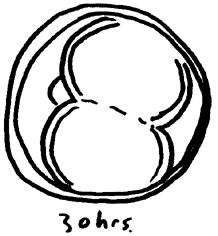 who did
great things and suffered for them, Simeon seemed to have become famous—
if he was famous, and I had never heard of him before— by doing absolutely
nothing. He had done nothing and yet got paid for it, so to speak. This struck
me as pretty shrewd. I was lazy by nature in those days— or rather, I
was a boy— and my idea of the good life was a perpetual holiday, with
a game of cricket occasionally to relieve the monotony, and I thought that old
Simeon had hit on an easy thing which in later life, if possible, I would do
my best to emulate.
who did
great things and suffered for them, Simeon seemed to have become famous—
if he was famous, and I had never heard of him before— by doing absolutely
nothing. He had done nothing and yet got paid for it, so to speak. This struck
me as pretty shrewd. I was lazy by nature in those days— or rather, I
was a boy— and my idea of the good life was a perpetual holiday, with
a game of cricket occasionally to relieve the monotony, and I thought that old
Simeon had hit on an easy thing which in later life, if possible, I would do
my best to emulate.
He was a romantic figure, too, because the details of his life were wrapped
in mystery. There was the one bald fact of the pillar; but all sorts of intriguing
questions arose as to how he lived there. How did he get his food, for instance?
Was it sent up to him in a basket at rcgular intervals, or did he rely on the
good nature of any casual passer-by? One thing seemed certain— he would
not go down for it. There was a saying; about Mohommad and a mountain, and it
seemed that in this case the mountain would most definitely have to go to Mohommad;
and then there was that other mysterious saying about faith moving mountains,
and it did not seem beyond the bounds of possibility that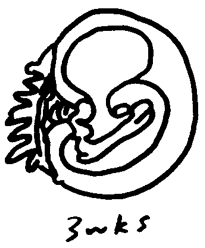 this miraculous old man— I imagined him as very old indeed, and of course
bearded— had been miraculously fed by birds or angels, as the tribes had
been fed by manna in the wilderness. Of course, there was always the simple
possibility that he had lived on his pillar without food, but this seemed far
too prosaic a solution to be true.
this miraculous old man— I imagined him as very old indeed, and of course
bearded— had been miraculously fed by birds or angels, as the tribes had
been fed by manna in the wilderness. Of course, there was always the simple
possibility that he had lived on his pillar without food, but this seemed far
too prosaic a solution to be true.
Then there was the further question of sleeping. Was Simeon in danger of falling off in more senses than one every night? For some reason, arising, I believe now, from the similarity in sound between Stylites and stilts, and also stiles, I was inclined to think of the old gentleman as performing some kind of balancing act on the top of a very flimsy wooden structure, rather like a music-hall comedian; and when I did get it into my head that the pillar was made stone it still appeared to me as very tall and very slender, with Simeon not so much seated as perched there, and I could not imagine how he ever managed to get a good night’s rest. Of course not doing any work all day he would hardly get tired, but still would need a few hours’ sleep every nigh t presumably, and did he manage to get it?
 There
was the final and fundamental question, the most intriguing of all, as to what
he did with his time. What could he do all day? He had solved the problem of
living without working, and that I admired him tremendously; but it did seem
to me, even at that early age, that there was sornething rather too negative
about an existence which involved simply not doing anything at all. My idea
of the good life was certainly one from which work was tirely absent, but this
was only a clearing of the ground, so speak, to make way for endless games and
amusements, and the number of possible games that could be played on top of
a pillar seemed to me to be limited, even when, as seemed likely from play,
there was a neighbour perched on his own pillar, not too away for neighbourly
intercourse. The problem remained: what did Simeon do all day?
There
was the final and fundamental question, the most intriguing of all, as to what
he did with his time. What could he do all day? He had solved the problem of
living without working, and that I admired him tremendously; but it did seem
to me, even at that early age, that there was sornething rather too negative
about an existence which involved simply not doing anything at all. My idea
of the good life was certainly one from which work was tirely absent, but this
was only a clearing of the ground, so speak, to make way for endless games and
amusements, and the number of possible games that could be played on top of
a pillar seemed to me to be limited, even when, as seemed likely from play,
there was a neighbour perched on his own pillar, not too away for neighbourly
intercourse. The problem remained: what did Simeon do all day?
This question, childish as it was and childish as it sounds, is nevertheless the fundamental question raised by the figure of the old man perched up there aloft. Why should the aged eagle spread his wings? is a later question, the question of the disillusioned, the disenchanted, the question of those who have reached a certain age, and who can see no reason for going forward any further. It was not a question that presented itself to me then. I thought of life, lazy as I was, as activity, pleasant activity. Simeon remained with me as a personification of glorious futility.
And yet it was obvious to me that he was, though futile, by no means a failure.
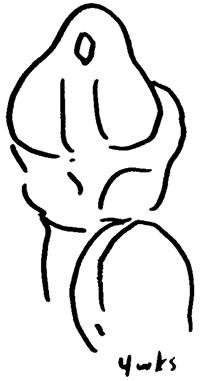 Apparently,
judging by the one-act play, people often went to see him—even crowds
of people. This seemed to me perfectly understandable. I was going to school
in the ’thirties, the sporting decade in which records were being broken
daily. There was Malcolm Campbell in his Bluebird, record-breaking
along some stretch of sand in far-away—California, was it? Daytona, perhaps?
There were non-stop dancing and piano-playing, couples going round and round
some dance-hall in Blackpool until they either stopped or dropped. And also
at Blackpool was some modern fakir, a one-time minister of religion, I think,
who lived in a barrel or did something or other in a barrel, and in whom the
police force seemed to be taking an interest. Then in the ’thirties came
Gandhi’s visit— Gandhi in his sheet and spectacles, the man who
fasted for phenomenal lengths of time. and alwavs seemed to get his way in the
end. Gandhi the religious Indian, the Christian clergyman fakir, the sporting
and dancing record-breakers, all seemed to have something in common with the
mythical figure of old Simeon on his perch, something essential to the type
of person who wants to go one better than everybody else in some mad direction
or other, someone who wants to shine and get into the news papers. Simeon had
succeeded, as Gandhi had succeeded; but was such success really worth it?
Apparently,
judging by the one-act play, people often went to see him—even crowds
of people. This seemed to me perfectly understandable. I was going to school
in the ’thirties, the sporting decade in which records were being broken
daily. There was Malcolm Campbell in his Bluebird, record-breaking
along some stretch of sand in far-away—California, was it? Daytona, perhaps?
There were non-stop dancing and piano-playing, couples going round and round
some dance-hall in Blackpool until they either stopped or dropped. And also
at Blackpool was some modern fakir, a one-time minister of religion, I think,
who lived in a barrel or did something or other in a barrel, and in whom the
police force seemed to be taking an interest. Then in the ’thirties came
Gandhi’s visit— Gandhi in his sheet and spectacles, the man who
fasted for phenomenal lengths of time. and alwavs seemed to get his way in the
end. Gandhi the religious Indian, the Christian clergyman fakir, the sporting
and dancing record-breakers, all seemed to have something in common with the
mythical figure of old Simeon on his perch, something essential to the type
of person who wants to go one better than everybody else in some mad direction
or other, someone who wants to shine and get into the news papers. Simeon had
succeeded, as Gandhi had succeeded; but was such success really worth it?
I never really bothered my head very much with the effort to answer this question. It was sufficient that I had managed to place old Simeon in his correct category. I had heard of Diogenes too: it seemed that at all times, and in all kinds of places, peculiar people had managed to do peculiar things, and get applauded forthem.
Then for a long time I forgot about Simeon. I passed into a civilized world from which genuine cranks were ostracized, and into which only the sham oddities, those who know the rules, and if they break them know how to break them comme il faut, are received with open arms. Simeon grew very remote indeed. After all, he had lived so long ago, and in Cilicia. Times had changed.
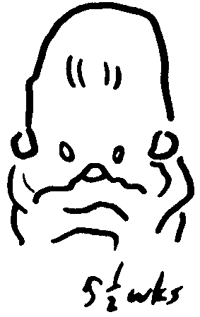 We
were not so rough now. Those hairy men of the past, always bearded, always either
grotesque in their voluminous clothing— there was a pre-Raphaelite picture
of Moses being held up to see . the Promised Land from afar in the Manchester
Art Gallery— or else disgustingly under-clad in their loin-cloths and
little else— they were all so remote. Unlike them, we dressed sensibly;
we used our Gillette blade daily; we bathed; we lived in civilized houses, not
tents; we went to the pictures. Simeon became almost prehistoric; it would have
been no surprise to learn that he had ridden to his pillar on a dinosaur or
a pterodactyl.
We
were not so rough now. Those hairy men of the past, always bearded, always either
grotesque in their voluminous clothing— there was a pre-Raphaelite picture
of Moses being held up to see . the Promised Land from afar in the Manchester
Art Gallery— or else disgustingly under-clad in their loin-cloths and
little else— they were all so remote. Unlike them, we dressed sensibly;
we used our Gillette blade daily; we bathed; we lived in civilized houses, not
tents; we went to the pictures. Simeon became almost prehistoric; it would have
been no surprise to learn that he had ridden to his pillar on a dinosaur or
a pterodactyl.
But then times changed again. The civilized world prepared war; went to war. The velvet glove was whisked away; the iron hand appeared. When you are encompassed by a world at war, Simeon’s glorious futility begins to seem less futile and more glorious. I discovered with delight that some sections of the civilized world took old bearded madmen like Simeon seriously. There was Helen Waddell’s Desert Fathers, for instance. Then, in a beautiful picture of the desert fathers, each in his separate little orbit of ground, encircled with flowers and being visited by tamed animals, I found a flowering wilderness, and this seemed to me a blessed counterpoise to the wildernesses that were being made of the modern cities as the bombs fell thicker and thicker. I began wonder whether those old madmen had been so mad after all, and whether maybe Simeon was not such a fool as he looked.
Since then I have learned a little more about St. Simeon; only a little, but
enough to increase rather than diminish my youthful astonishment at this astonishing
man. Apparently he was not always old and bearded after all, in fact as a boy
he seems to have been quite a norrnal son of a shepherd— that is to say,
a young shepherd himself— until one day, after going to church, he becat
suddenly convinced that he must go into a monastery. Of the mystery, the providentiality
of that impulse, what is there to be said? 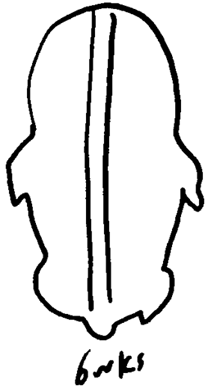
His mode of entry into the monastery was unusual but characteristic: he lay on the ground outside the gates of the building for five days and nights, until finally they let him in. He seems rather to have enjoyed the experience, for once in themonastery he started doing more outrageous things of a similar kind. When the others objected, he ran off to a deserted tank, hid himself there, was discovered and dragged back by main force. He did not see why they should object to his eating only one day a week when he was giving the rest of his food to the poor; nor why he should not bind his body with a tight cord so that the flesh grew over it, if he felt it necessary thus to chastise the rebellious flesh. His fifth-century monastery was not given to what we should describe as self-indulgence, but evidently it was too soft for Simeon, for after a year he was off again, and this time for good.
He went to a nearby mountain, the Telanassus; and it was here that he eventually became famous, ensconced on his pillar. He did not immediately go to the top of the mountain but lived in the comparative luxury— after an introductory fast lasting forty days— on a little house under the peak. He spent three years here; then he went up higher— to the top. At once, lest he might in a moment of weakness wish to escape, he walled himself in. But he was taking no chances; remembering that stone walls do not a prison make, he obtained a large iron ball, and chained himself to it. One day Meletius, the Bishop of Antioch’s vicar, visited him. If the will was truly there, he remared, the chain would be unnecessary. For all his austerities, Simeon was not above taking a hint from a prelate, and obediently he unhooked himself. The will did in fact prove to be there, for the saint remained on his mountain-top until he died.
According to his two friends, disciples and biographers, Anthony and Theodoret,
the result of all this splendid isolation was an immense number of conversions
amongst the wild Arabian tribes who had ignored Christianity’s milder
missionaries. God, says Theodoret, is pleased to raise up saints distinguished
by different marks of sanctity appropriate to different times; and the wild
Iberi, Persians, Ishmaelites and Armenians evidently needed a man as wild in
his 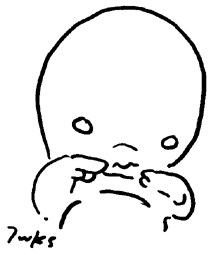 sanctity
as they were savage in their lives before they could be brought to the waters
of baptism. Anyway, they were so impressed by the ferocity which this old man
of the mount vented upon himself that they flocked to him in droves to be converted.
I have wondered whether a sense of humour of a rather shrewd and countrified
kind was tucked away somewhere behind the austerities; for Simeon, in an effort
apparently to flee from his increasing popularity-, did not move horizontally
but vertically. The will was still there; not even notoriety could break it;
and Simeon’s pillar, which had begun by being six cubits high, rose to
twelve. In the end it reached a height of thirty-six cubits, and still the shaggy
converts came. Simeon seems to have taken little pride in his elevation, for
at a word from his superiors, the bishops and abbots of the surrounding regions
(was Meletius one of them, one wonders?), he showed himself perfectly willing
to come down to earth; but the authorities, having tested his obedience and
humility, decided not to clip the old eagle’s wings atter all, Simeon
remained on his high pillar, up on the mountain peak.
sanctity
as they were savage in their lives before they could be brought to the waters
of baptism. Anyway, they were so impressed by the ferocity which this old man
of the mount vented upon himself that they flocked to him in droves to be converted.
I have wondered whether a sense of humour of a rather shrewd and countrified
kind was tucked away somewhere behind the austerities; for Simeon, in an effort
apparently to flee from his increasing popularity-, did not move horizontally
but vertically. The will was still there; not even notoriety could break it;
and Simeon’s pillar, which had begun by being six cubits high, rose to
twelve. In the end it reached a height of thirty-six cubits, and still the shaggy
converts came. Simeon seems to have taken little pride in his elevation, for
at a word from his superiors, the bishops and abbots of the surrounding regions
(was Meletius one of them, one wonders?), he showed himself perfectly willing
to come down to earth; but the authorities, having tested his obedience and
humility, decided not to clip the old eagle’s wings atter all, Simeon
remained on his high pillar, up on the mountain peak.
From this vantage point he preached, it is said, twice daily, sometimes for
hours on end. Of course he fasted and prayed. He healed the sick. He even became
a sort of judge. 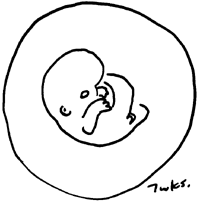 It
was here that his uncomprehending mother came to visit him and died, wailing
that flesh of her flesh should so cruelly have mortified itself; and her son
wept with her. Here too came a thief, Jonathan by name to be protected, converted
and dead, all within a week. And at last the old man himself died, after being
clasped to his pillar in prayer for three days. The body was taken down by the
faithful Anthony, carried to Antioch, and buried with great pomp and reverence.
It
was here that his uncomprehending mother came to visit him and died, wailing
that flesh of her flesh should so cruelly have mortified itself; and her son
wept with her. Here too came a thief, Jonathan by name to be protected, converted
and dead, all within a week. And at last the old man himself died, after being
clasped to his pillar in prayer for three days. The body was taken down by the
faithful Anthony, carried to Antioch, and buried with great pomp and reverence.
I have a feeling that this saint is still looked a bit askance
at, by the average Catholic, as he is certainly a figure of fun
to the average non-Catholic. And for a time, when my one wish was to be utterly
orthodox in all things, both great and small, I tried to feel the same way about
him and to convince myself that sanctity was more appropriately achieved in
drawing-rooms with St. Francois de Sales than on the top of a pillar with St.
Simeon. But as the times change again, becoming ever again the same, and the
world prepares for another world war, waged with atomic weapons this time, I
begin to return to my old favourite, and with increased fervour. Extraordinary
ages call for extraordinary characters; extraordinary diseases for extraordinary
cures. St. Simeon is for me the perfect figure of the extraordinary saint. I
think we need more of him.
For what, after all, do we— do I— admire St. Simeon so enthusiastically
for? It is for that terrific talent of his for doing nothing. There is no finer
slap in the eye to the modern world than that. It is a phenomenon that the modern
world finds not only incomprehensible but reprehensible and even criminal, and
there are strong reasons for thinking that the modern world needs a good slap
in the eye. St. Simeon stands— or sits, or perches— as the pure
contemplative, the eagle up aloft in his eyrie gazing at the sun, the look-out
man in the crow’s nest. I know that the text-books will tell you—and
the lives of most saints truly witness— that the life of contemplation
does not mean a life that is physically- inactive; that the great contemplatives
have been great men of action. But it is the other kind of contemplative life,
the other kind of sanctity, that I think the modern world needs.
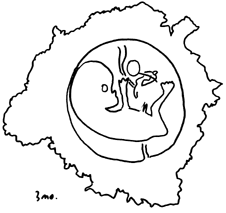
“Teach us to care and not to care.
Teach us to sit still.”
St Simeon had certainly leamed to sit still, and he if anyone amongst the saints of Christendom can teach us how to, do the same.
For why can’t we sit still? Why must we be always doing?
lt is because the active life of the West does not feed the soul, because it so destroys our spiritual resources that even the briefest respite
from it brings a sense of boredom. I am sure that most of the restlessness of
the West arises from this fear of boredom, and bordome means being brought face
to face with our own emptiness. Therefore that childish question: what did old
Simeon do all day? highly relevant. If we could say no more about him than that
he faced boredom, wrestled with it, did not succumb to it— did not descend
from his pillar—but conquered it and remained up there doing nothing,
then I think that would be sufficient to make him a worthwhile study and counterblast
to the present day.
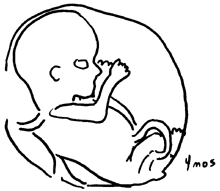
But Simeon didn’t go right away from the towns, from civilization;
he went so far and no further; far enough to be away, to be out of it all, not
far enough to be ignored and forgotten. Perched up there on his pillar, he was
and is a living reproach to the active city-dwellers, the everlasting compromisers
who aim to make Our time has seen, thanks chiefly to Graham Greene, a revival of interest in
the theme of the hunted man. It is a theme dear after all in its sentimental
guise to the English heart; hence the popularity of Galsworthy’s Escape.
Presented less sentimentally by Greene, it reveals a deeper religious fact,
of a kind traditional in our literature and finding one of its most cornpelling
expressions in Francis Thompson’s Hound of Heaven: I fled him
down the arches of the years. I think the time has come when the religious
undertones of another familiar figure should be sounded—the figure of
the Guy. Not the American guy, the good guy, but the English guy, the guy shortly
to be burned in effigy by the boys I have been helping to cart autumn prunings
away from my garden. They will have a big stuffed guy up above their fire, and
fortunately they will be quite indifferent as to whether it is a Catholic or
Protestant or a Hottentot they are burning in effigy. But it has occurred to
me that if St. Simeon appears at first sight as a similar sort of guy, someone
if not to be burned by the mob at least to be taken pot-shots at, a most helpless
sitting target for all the pagan scorn of mankind— then
at second sight he may teach us to have pity on all poor guys, and realize that
in a surprising number of cases the English guy may turn out to be the American
guy—the regular guy becomes the regular guy. Guy Fawkes and St. Simeon
raised up above the jeering populace, have after all a heavenly prototype, and
every guy deserves our pennyworth of thanks, if only in memory (if one may speak
so without I mentioned Leon Bloy, the great modern outcast, another guy or curio. No one,
perhaps, has fulminated more violently against the modern world than he; no
one has revealed so frankly the great amount of pure hatred of mankind that
may be mixed up in fervent and in fact quite overpowering love of God and the
poor. If we were warned against the dangers in such a spirit (which nevertheless
helped -o produce a Maritain), there would no doubt be reason in the warning.
But in St. Simeon we see all that is positive in Bloy’s reaction against
the civilized world extracted from the merely human husk that is harmful: the
great assertion No Compromise.
I do not know—I do not even know if anyone knows—the contents of
any of St. Simeon’s lengthy sermons. What I do know is that the people
went to him—he did not go to the people; and that they went in droves.
Imagine this figure perched up on the top of a high stone a few miles outside
London, say, or New York. What would our modern reactions be? Would St. Simeon
have any news value now? Suppose he was visited by flocking sightseers, out
of a sense of fun, and suppose he made this simple announcement, that the world
being as it is, he had been obliged to adopt his peculiar way of life because
it was the only way he could follow in his pursuit of holiness. What could we
reply? That our virtue is such that we feel safer in the cities? Or that our
faith is so lukewarm that we prefer to remain as we are?
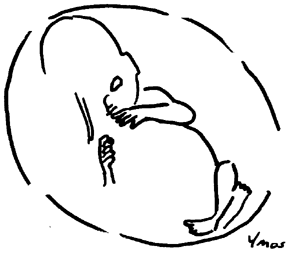 the
best of both worlds—and certainly manage to make the best of this one.
He was a thorn in the flesh of the civilized hide of mankind, that hardened
hide which is so firm against the supernatural. Simeon did nothing— except
live for God: hence he became St. Simeon. But even if we forget about the achieved
sanctity the supernatural fruit of what in fact he did up there,
while seeming to do nothing— if we forget all that and concentrate merely
on the human gesture, then there is still plenty for us to admire. I take Simeon
as my favourite saint because he dwells, so to speak, at the easternmost end
of western Christendom, because he embodies that otherworldliness of the East
which has managed to get christianized. He has, most of the West may say, only
just managed get in: we need to be warned, they will add, against all that is
extreme in his example, particularly the spiritual pride that may easily lie
behind such an extraordinary mode of life. Precisely the opposite seems to me
to be the truth. For the Christian religion like the rest of the world, is suffering
from an overdose of Westernism: we need a potent injection from the East, the
more violent, the more remarkable the better.
the
best of both worlds—and certainly manage to make the best of this one.
He was a thorn in the flesh of the civilized hide of mankind, that hardened
hide which is so firm against the supernatural. Simeon did nothing— except
live for God: hence he became St. Simeon. But even if we forget about the achieved
sanctity the supernatural fruit of what in fact he did up there,
while seeming to do nothing— if we forget all that and concentrate merely
on the human gesture, then there is still plenty for us to admire. I take Simeon
as my favourite saint because he dwells, so to speak, at the easternmost end
of western Christendom, because he embodies that otherworldliness of the East
which has managed to get christianized. He has, most of the West may say, only
just managed get in: we need to be warned, they will add, against all that is
extreme in his example, particularly the spiritual pride that may easily lie
behind such an extraordinary mode of life. Precisely the opposite seems to me
to be the truth. For the Christian religion like the rest of the world, is suffering
from an overdose of Westernism: we need a potent injection from the East, the
more violent, the more remarkable the better. 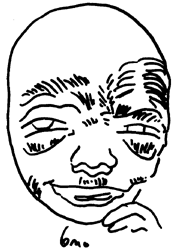 The
prime characteristic of Westernism is that it puts this world first— puts
it first not only unreflectingly, but as its first principle of action. Simeon
did the Opposite. He may not, like Leon Bloy, have spat on the world, but he
turned his back on it, and he tunled his face to the sun. Simeon represents
a type that has always fascinated me, that of the outcast, the Ishmael, the
scapegoat. But he is an outcast of a peculiarly intransigent kind: he does not
go and hide himself away in a hole in the desert, he goes a certain distance
(not too far) from the town and there sets up shop. He is, if
you like, an exhibitionist, in the most literal meaning of the word; he is determined
to make an exhibition of himself. Presumably he had a reason for doing so; and
presumably, since he is Saint Simeon, his reason was a valid one. I take it
that his reason was to cock a snook at the world, to behave as impertinently
towards civilization as civilization behaves towards God. It is a transvaluation
of all values to go and live up in the air, feet off the ground, permanently.
It is to behave as daringly as Icarus, except for the solid rock of sanctity
underneath. There is a cheekiness about it that offends more modest, more self
effacing types of saintliness; an oriental extravagance, divested of all oriental
splendour, that strikes me as particularly appropriate and relevant today.
The
prime characteristic of Westernism is that it puts this world first— puts
it first not only unreflectingly, but as its first principle of action. Simeon
did the Opposite. He may not, like Leon Bloy, have spat on the world, but he
turned his back on it, and he tunled his face to the sun. Simeon represents
a type that has always fascinated me, that of the outcast, the Ishmael, the
scapegoat. But he is an outcast of a peculiarly intransigent kind: he does not
go and hide himself away in a hole in the desert, he goes a certain distance
(not too far) from the town and there sets up shop. He is, if
you like, an exhibitionist, in the most literal meaning of the word; he is determined
to make an exhibition of himself. Presumably he had a reason for doing so; and
presumably, since he is Saint Simeon, his reason was a valid one. I take it
that his reason was to cock a snook at the world, to behave as impertinently
towards civilization as civilization behaves towards God. It is a transvaluation
of all values to go and live up in the air, feet off the ground, permanently.
It is to behave as daringly as Icarus, except for the solid rock of sanctity
underneath. There is a cheekiness about it that offends more modest, more self
effacing types of saintliness; an oriental extravagance, divested of all oriental
splendour, that strikes me as particularly appropriate and relevant today. 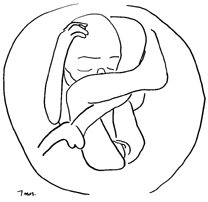
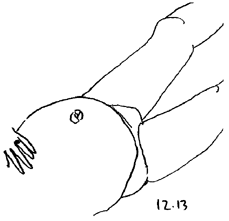 blasphemy)
of the Greatest of all the Guys who have ever been raised up above the self-righteous
heads.
blasphemy)
of the Greatest of all the Guys who have ever been raised up above the self-righteous
heads.
I do not think that I am in any danger now of confusing St. Simeon
with the mere record-breakers. I do not imagine now that he wanted to outshine
anyone eise. But I am still firmly convinced that he wanted to shine—
with holiness. ’’Let your light so shine before men....
A city that is set on a hill cannot be hid....’ Neither do men
light a candle and put it under a bushel.... And though holiness may
shine in drawing-rooms, and saints may brave the rigours of afternoon tea and
scandal for our enlightenment and encouragement, nevertheless our world seems
to demand a different kind of sanctity, a sanctity whose impulse from the human
side is as extraordinary and as radical as the world we live in. 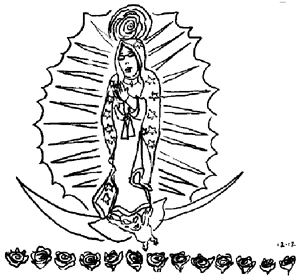
But after all, I do more than admire this saint, I really love him. And why? Because I am a timid modern, a vitiated city-dweller; also (I must confess in a whisper) a bit of a guy myself, a bit of an English guy, a Peculiar Person. St. Simeon is myself as I would like to be, if I had the heroism of the saint instead of the cowardice of the sinner. I should like to have the courage to face mockery from those who mock what I love; I should like to welcome the brickbat. I should like to be up there on a pillar, instead of down on the ground with the crowd, hiding my sympathy with the man up aloft. There is safety in numbers, and so Simeon went up alone; there is dizziness for the timid at the prospect of great heights, and Simeon faced it. The modern world has developed its own methods of conquering space. Perhaps Simeon’s way of conquering it was better: he reduced his contact with earth to a minimum, but he remailled earth-bound. He is an excellent symbol of our faith, which is sanctified commonsense. The funny thing is that sanctified commonsense takes such uncommon forms.
I think of that man of rock, a sage, a man of God. Come in under the
shadow of this red rock. It is because he lives in my mind with all the
strength of the rock he lived on that I long to creep in under the shadow of
that pillar and that sanctity of his; because he rises there like a beacon out
of a better land and a better time, when sanctity was more gaunt, more sirnple,
more heroic, when the eternal choices were clearer under the everlasting stars,
Heaven and Hell closer, the sword of the spirit more ruthless. Mankind has al~ays
hankered after a Golden Age, set either backwards or forwards in time: if in
the past, with great men ten feet high, if in the future, winged. Simeon was
not winged, but he had done his best to get away from earth; he was not ten
feet high, but he had managed to get higher still. My picture of him is largely
imaginative, you see: he is my perfect spiritual father.
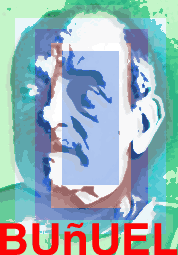
“The portrait of a saint,” writes Clare Boothe Luce, “is only a fragment of a great and still uncompleted mosaic—the portrait of Jesus.” Although a sizable portion of Christendom (including the Roman Catholic, Anglican and Orthodox communions) honors the saints as man’s intercessors with God, historical distances have dimmed most saintly portraits even for the modern Christian, to say nothing of the skeptic who lives next door. To show the “timeliness” of the saints in 1952, Clare Luce has edited Saints for Now .
“Come in under the shadow of this rock,” pleads Christian historian George Lamb, echoing St. Simeon the Elder, reputedly the first and definitely the most famous of the long succession of stylitoe, or “pillar hermits”, who, during more than six centuries, writes theologian Herbert Thurston, “acquired by their strange form of asceticism, a great reputation for holiness throughout eastern Christendom.”
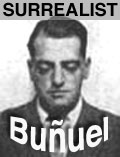
Lubac, Henri de, Aspects of Buddhism, 1954
Mouroux, Jean, The Christian Experience: An Introduction To A Theology, 1954
Marrou, H. I., A History of Education in Antiquity, 1956
Jouhandeau, Marcel,. St. Philip Neri, 1960
da Capua, R aimonda, The Life of St. Catherine of Siena, 1960